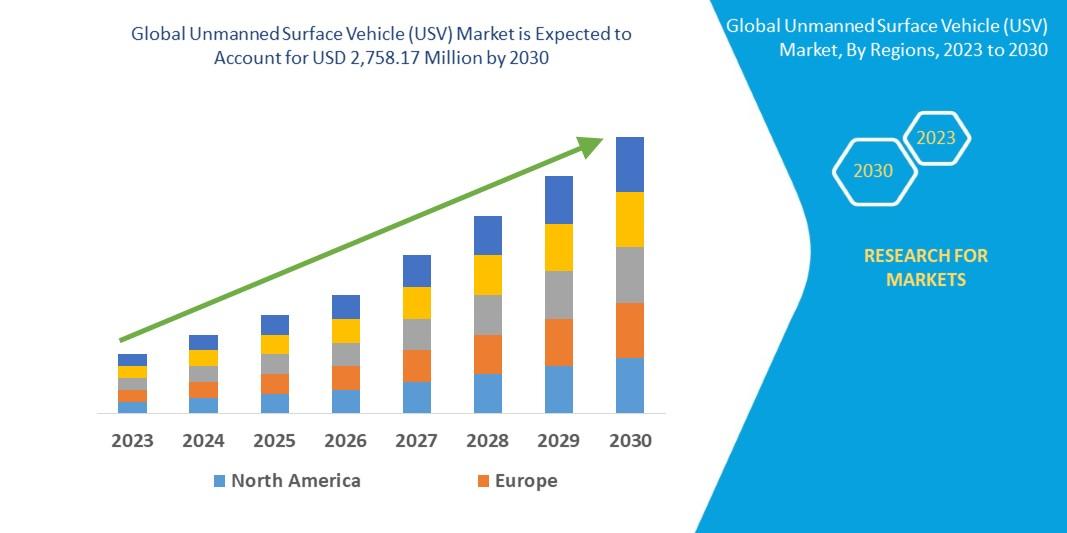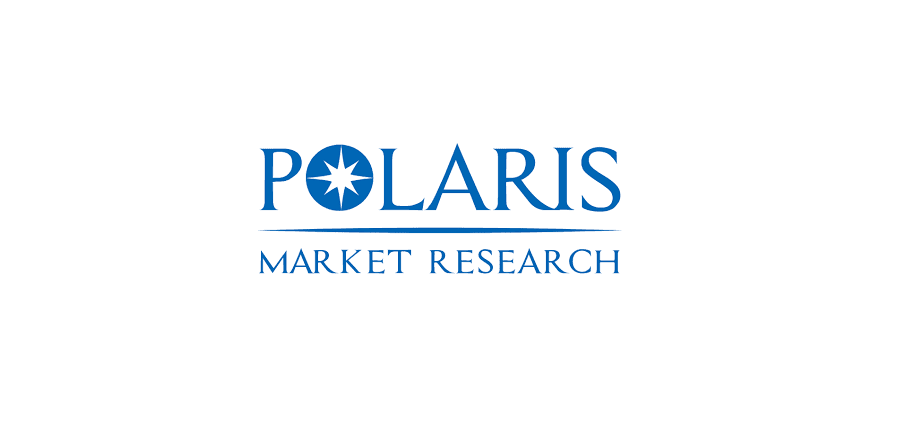Unmanned Surface Vehicle (USV) Market Size, Share, Growth Forecast, Trends & Segment Analysis

Unmanned Surface Vehicles (USVs) are autonomous or remotely operated vessels that perform missions on the water’s surface without a human crew onboard. USVs range from small, portable craft used for surveying to large, ocean-going platforms supporting defense, offshore energy, and scientific missions. Advances in autonomy, sensors, propulsion, and communications, combined with rising requirements for maritime security, cost-effective data collection, and reduced human exposure to hazardous environments, are driving rapid development and deployment of USV solutions.
Data Bridge Market Research analyses that the global unmanned surface vehicle (USV) market is expected to reach the value of USD 2,758.17 million by 2030, at a CAGR of 13.7% during the forecast period.
Market Overview
The USV market is maturing from niche prototypes and research projects into commercially viable systems for defense, civil, and commercial users. Technological convergence—artificial intelligence for autonomy, high-resolution sensors (sonar, LiDAR, synthetic aperture radar), secure data links, and resilient power systems—has increased the operational envelope and mission reliability of USVs. Demand is growing for modular, mission-configurable platforms that can be adapted quickly for surveillance, inspection, bathymetric surveying, environmental monitoring, and anti-submarine/force-protection roles.Key Growth Drivers
-
Defense & Maritime Security Needs
Navies and coast guards seek persistent, lower-cost options for maritime domain awareness, mine countermeasures, anti-submarine warfare, and force protection. USVs reduce personnel risk and extend reach for routine and hazardous missions. -
Cost Efficiency vs. Manned Platforms
Lower acquisition and lifecycle costs compared with crewed vessels—plus reduced crewing and logistics overhead—make USVs attractive for commercial operators such as fisheries, ports, and offshore energy firms. -
Expansion of Offshore Industries
Offshore wind, oil & gas, and seabed mining require regular inspection and monitoring. USVs provide reliable, repeatable survey data for asset integrity, environmental compliance, and installation support. -
Advances in Autonomy & AI
Improved autonomy algorithms, sensor fusion, and onboard decision-making allow USVs to operate in complex, cluttered maritime environments with reduced human intervention. -
Environmental Monitoring & Scientific Research
Governments and research institutions increasingly use USVs for long-duration data collection, oceanographic studies, pollution response, and fisheries management.
Market Segmentation
By Platform Size
-
Micro / Small USVs (portable, low-cost, short-range)
-
Medium USVs (mission-flexible, multi-day endurance)
-
Large USVs (long-endurance, multi-role, oceangoing-capable)
By Propulsion / Powertrain
-
Electric / Hybrid-Electric
-
Diesel / Conventional Engines
-
Fuel Cell & Alternative Energy (solar-assist, wave-energy hybrids)
By Autonomy Level
-
Remotely Operated (ROV-like control)
-
Assisted Autonomy (waypoint + limited decision-making)
-
Full Autonomy (sense-plan-act onboard intelligence)
By Application
-
Defense & Security (surveillance, MCM, ASW)
-
Hydrographic & Bathymetric Surveying
-
Offshore Energy Support & Inspection
-
Environmental Monitoring & Research
-
Port & Harbor Surveillance
-
Logistics & Uncrewed Cargo Trials
By End User
-
Navies and Coast Guards
-
Offshore Energy Operators
-
Survey & Mapping Firms
-
Environmental & Research Institutions
-
Port Authorities and Maritime Security Providers
-
Commercial Shipping & Logistics Firms
Technology & Capability Trends
-
Sensor Miniaturization & Integration: Compact, high-resolution multibeam sonars, side-scan sonars, LiDAR, and hyperspectral sensors are becoming standard payloads.
-
Edge AI & Onboard Processing: Real-time anomaly detection, target classification, and adaptive mission re-planning without continuous remote control.
-
Communications Resilience: Multi-link comms (SATCOM, LTE/5G, HF/UHF) with mesh networking for swarms and beyond-line-of-sight operations.
-
Modularity & Payload Swaps: Quick-change mission bays allow a single hull to support survey, ROV deployment, and ISR roles.
-
Swarm & Cooperative Operations: Coordinated behaviors among multiple USVs and unmanned systems (AUVs, UAVs) for distributed sensing and complex mission coverage.
Competitive Landscape
The market features defense primes expanding into unmanned maritime solutions, specialized USV manufacturers, systems integrators, and emerging startups. Competitive differentiation centers on autonomy software, sensor integration expertise, proven maritime endurance, data-management services, and compliance with maritime safety/regulatory frameworks. Strategic partnerships between navies, universities, and industry are accelerating capability validation and procurement.
Challenges & Constraints
-
Regulatory & Maritime Rules of the Road: Lack of universally accepted regulations for unmanned surface navigation complicates commercial deployment in busy waterways.
-
Communications & Cybersecurity Risks: Secure, reliable beyond-line-of-sight links and protection against cyber threats remain essential.
-
Operational Acceptance & Trust: End users require demonstrated reliability, safety, and predictable behavior prior to scaling USV fleets.
-
Environmental & Sea-State Limitations: Harsh sea conditions and biofouling affect endurance and sensor performance; hull design and maintenance are critical.
-
Interoperability & Standardization: Varied platforms and proprietary systems hinder multi-vendor cooperative missions.
For More Related Reports :
Global Automotive Original Equipment Manufacturer (OEMS) Market
Global Men’s Health Market
Global Disinfectant Wipes Market
Global Horticulture Lighting Market
Global Makeup Remover Market
Global Atomic Force Microscope (AFM) Market
Global Polyvinyl Chloride (PVC) Compound Market
Global Molecular Breeding Market
Global Taurine Market
Global Collagen Drinks Market
Global Sunflower Oil Market
Global Paper Chemicals Market
Global Vegan Ice-Cream Market
Global Document Camera Market
Global Phosphorus Trichloride Market
Future Outlook & Opportunities
Expect steady adoption across defense and commercial sectors as regulations mature and more real-world demonstrations succeed. High-growth opportunities include:
-
Long-endurance survey contracts for offshore wind and seabed mapping.
-
Mine countermeasure (MCM) and persistent ISR programs in defense budgets.
-
Swarm-enabled fleet services for rapid wide-area search and monitoring.
-
Data-as-a-Service models where operators monetize processed ocean-data outputs.
-
Integration with port automation and green shipping corridors to support logistics and emissions reduction initiatives.
Conclusion
Unmanned Surface Vehicles are poised to become a backbone technology for modern maritime operations—offering safer, cheaper, and more persistent presence on the water. The speed of market expansion will depend on progress in autonomy, regulatory clarity, robust communications, and proven return-on-investment cases. Stakeholders that deliver reliable, modular platforms with strong data services and compliance-ready solutions will lead the next wave of maritime transformation.
Contact Us:
Data Bridge Market Research
US: +1 614 591 3140
UK: +44 845 154 9652
APAC : +653 1251 975
Email:- corporatesales@databridgemarketresearch.com



